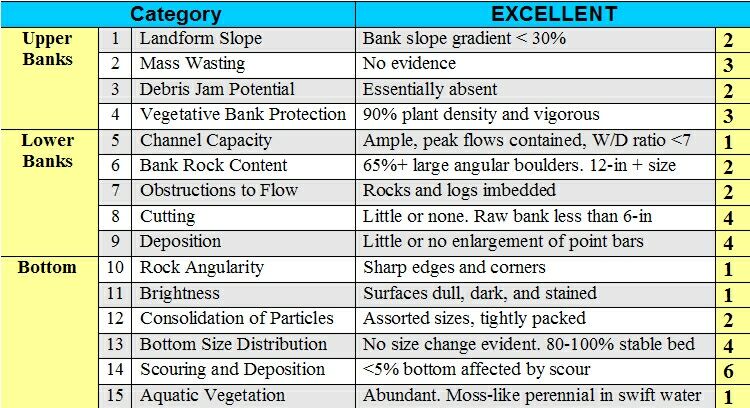
| glossary | menu | Normal | lg | hc | 8.) Rosgen Classification of Stability and Change > Field Assessment of Stability |
| < Previous | 1 | 2 | 3 | 4 | 5 | 6 | 7 | 8 | 9 | 10 | 11 | 12 | 13 | 14 | 15 | 16 | 17 | 18 | 19 | 20 | 21 | 22 | 23 | Next > |
Field Assessment of Stability

Field assessments of channel stability might include monitoring permanent channel cross sections to quantify lateral and vertical departures and then anticipate FGM stability and evolution.
Pfankuch (1975) created a relative channel stability ranking for the U.S. Forest Service in the central and western US states, which Rosgen modified to consider channel types. In this modified index ranking, a lower index value indicates higher stability and low sensitivity to disturbance. A higher index value indicates lower stability and higher sensitivity to disturbance.
In this field-based ranking system, channel features of the upper banks, lower banks, and bottom are assessed for a variety of categories. Once the condition of each category is determined, its rank is tallied to arrive at a summative index value, which is evaluated based on channel type. This allows for determination of the channel stability ranking as good, fair, or poor.
In this figure, the Pfankuch table for Excellent Stream stability is shown. Similar tables for good, fair, and poor condition Streams are provided in the exercises. Based on field analysis, descriptors are noted on the table, and then a summative score using the right column is determined to rank the Stream stability. This ranking is then converted to a conditional rating based on Rosgen Stream type.
Image modified courtesy of Rosgen
| < Previous | 1 | 2 | 3 | 4 | 5 | 6 | 7 | 8 | 9 | 10 | 11 | 12 | 13 | 14 | 15 | 16 | 17 | 18 | 19 | 20 | 21 | 22 | 23 | Next > |